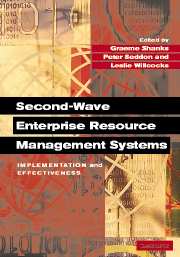Book contents
- Frontmatter
- Contents
- List of Contributors
- Introduction: ERP – The Quiet Revolution?
- Part I Implementation and Effectiveness: Overview
- Part II From Risks to Critical Success Factors
- 5 Enterprise System Implementation Risks and Controls
- 6 Risk Factors in Enterprise-wide/ERP Projects
- 7 A Framework for Understanding Success and Failure in Enterprise Resource Planning System Implementation
- 8 Critical Success Factors Revisited: A Model for ERP Project Implementation
- 9 Offsetting ERP Risk through Maintaining Standardized Application Software
- Part III From Learning to Knowledge
- Part IV Cultural Aspects of Enterprise Systems
- Part V Future Directions
- Index
- References
8 - Critical Success Factors Revisited: A Model for ERP Project Implementation
from Part II - From Risks to Critical Success Factors
Published online by Cambridge University Press: 05 February 2012
- Frontmatter
- Contents
- List of Contributors
- Introduction: ERP – The Quiet Revolution?
- Part I Implementation and Effectiveness: Overview
- Part II From Risks to Critical Success Factors
- 5 Enterprise System Implementation Risks and Controls
- 6 Risk Factors in Enterprise-wide/ERP Projects
- 7 A Framework for Understanding Success and Failure in Enterprise Resource Planning System Implementation
- 8 Critical Success Factors Revisited: A Model for ERP Project Implementation
- 9 Offsetting ERP Risk through Maintaining Standardized Application Software
- Part III From Learning to Knowledge
- Part IV Cultural Aspects of Enterprise Systems
- Part V Future Directions
- Index
- References
Summary
Introduction
Implementation of ERP systems is widely recognized (Parr, Shanks, and Darke, 1999; Ambrosio, 1997; Fine, 1995; Gartner Group, 1998; Horwitt, 1998; Stedman, 1998a, 1998b; Martin, 1998; Piszczalski, 1997; Tebbe, 1997) as both problematic, and likely to overrun time and budget allocations for the actual implementation project. Of course IT projects do have a history of having such problems but ERP implementations are more intractable than most. Martin (1998) reported that over 90% of ERP implementations were late and/or over budget; some have terminated in expensive legal actions (James, 1997; Shanks et al., 2000); and the popular literature (Infoweek, Computerworld, etc.) contains numerous stories which describe ERP implementations in colourful terms, such as ‘endurance’ tests, ‘fiascos’, ‘living to tell about it’, and ‘war stories’ (see, for example, Tebbe, 1997; Horwitt, 1998).
In response to these problems, the academic literature has taken a two-pronged approach. First, it has focused on CSFs (Parr, Shanks, and Darke, 1999; Holland, Light, and Gibson, 1999; Sumner, 2000; Shanks et al., 2000; Parr and Shanks, 2000b) for implementation of ERP systems. Secondly, it has developed process models of successful implementation (Bancroft, 1996; Bancroft, Seip, and Sprengel, 1998; Markus and Tanis, 2000; Holland, Light, and Gibson, 1999; Parr, Shanks, and Darke, 1999; Ross, 1998). Both approaches aim to achieve more successful implementation and deeper insight into the process.
- Type
- Chapter
- Information
- Second-Wave Enterprise Resource Planning SystemsImplementing for Effectiveness, pp. 196 - 219Publisher: Cambridge University PressPrint publication year: 2003
References
- 6
- Cited by



